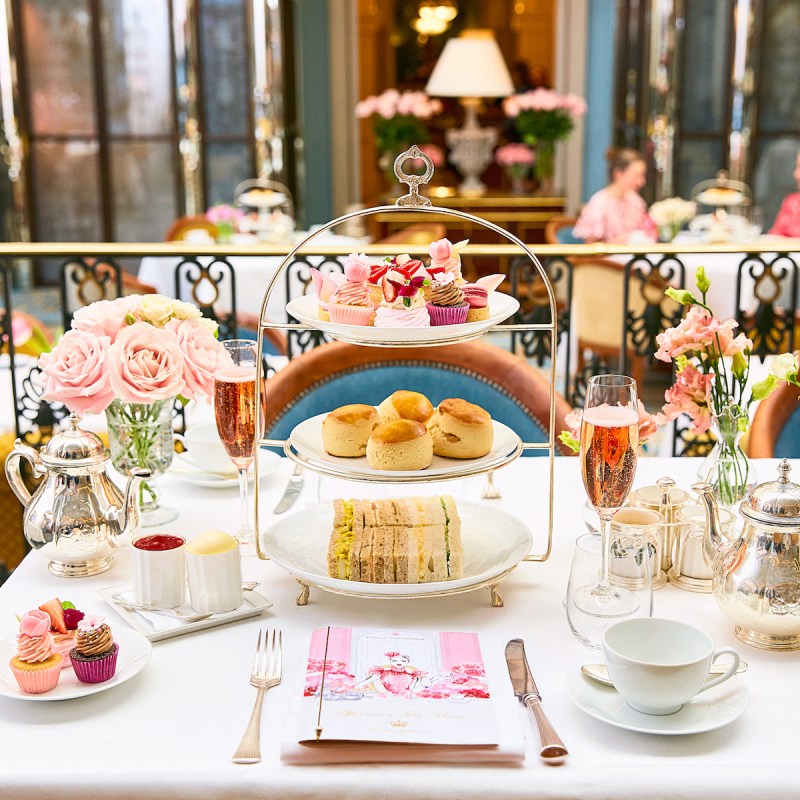
Although a lot of English traditions might seem complicated and confusing to anyone traveling here from abroad, most of those quirky rituals of ours have their roots in practicality. When it comes to high tea and afternoon tea, the reasons behind these traditions, how they differ, and what they consist of might surprise you. Many people don’t realize there is a difference between afternoon tea and high tea at all, and although the differences might seem subtle, there are historical and cultural reasons behind them.
Videos by TravelAwaits
In London, especially, afternoon tea is taken seriously, and although it’s now a treat rather than something everyone takes part in every day, it’s useful to know what to expect before you get here. As for high tea, it’s very misunderstood. Most people don’t know what it is and have never tried it, even most British people. So, before you visit, here’s everything you need to know about these two British food traditions.
What Is Afternoon Tea?
Afternoon tea came about in the 19th century, when the Duchess of Bedford found waiting till 8 p.m. for dinner was just too long. She was hungry around 4 p.m. and wanted something to fill the gap. After asking for some small sandwiches and cake to be sent to her room with a pot of tea, she soon grew this idea with her friends into a social get-together, and afternoon tea started to take off. This was something only the higher classes could enjoy as it was rather fancy and involved foods the working classes could never afford. It was called afternoon tea because of the tea-drinking element, but today especially, it is more about the food involved than the drinking of tea.
Afternoon tea usually arrives on a large elaborate tiered cake stand. One layer is small delicate sandwiches, another is scones with cream and jam, and lastly, a selection of small cakes – on their own, scones, cream, and jam are called a “cream tea.” You can read more about cream teas in “Cornwall vs. Devon: The Contentious Cuisine Debate Dividing The UK.” The afternoon tea would traditionally arrive with a pot of tea, but now you have the option of including champagne if it’s for a special treat. Afternoon tea these days is more of a treat than a daily ritual, as it once was, and it’s usually enjoyed on special occasions now.

Best Places For Afternoon Tea
Town House
Celebrating the best of London, Town House at The Kensington invites visitors and guests alike to indulge in the London Landmark’s Afternoon Tea, which takes in inspiration from London’s most recognizable and historic landmarks. Guests will be taken on a tasty foodie tour of some of the capital’s most famous architectural feats from the opulent surroundings of Town House restaurant. The Afternoon Tea is presented on a London Eye-inspired tea stand, served alongside a beautiful bespoke map of London illustrated by Eleni Sofroniou, highlighting the landmarks featured in the tea, which guests can take home with them.
Starting with a skyline of scones and sandwiches, guests will also enjoy a selection of savory treats including a cockney staple steak & London ale pie and a Colston Bassett Stilton and broccoli quiche alongside a bite-size crab cake with tartare sauce and caperberries. Those with a sweet tooth will delight with London Landmark creations including “The Gherkin,” crafted from white chocolate with a dark chocolate ganache; “The Shard,” made of carrot cake and milk chocolate; an iconic “London Telephone Box” imagined in rhubarb mousse; and a Big Ben-inspired lemon curd tart.
Town House is the signature restaurant at The Kensington Hotel and is spread across three classically designed drawing rooms, serving locally-sourced, seasonal modern British cuisine. Nestled in the heart of one of London’s most desirable neighborhoods, Town House also provides intimate porticos overlooking South Kensington’s tree-lined avenues.

The Lanesborough Hotel
The Lanesborough Hotel in London is offering an exclusive afternoon tea experience in collaboration with world-famous baker Peggy Porschen. Combining one of London’s most beautiful afternoon tea settings – under the naturally illuminated domed glass roof of Michelin-starred Céleste – with the fairy tale pink aesthetics of Peggy Porschen, guests can expect a celebration of beautiful floral features.
Founder and life-long baker Peggy has “returned home” to The Lanesborough where she held her first prestigious pastry chef position in 1999 after graduating from Le Cordon Bleu’s “The Grand Diploma of Cuisine & Patisserie.” Alongside her skilled pastry chef team, Peggy has designed a unique afternoon tea experience in collaboration with The Lanesborough’s charismatic head pastry chef, Kevin Miller, who recently came runner-up on Channel 4’s Bake Off: The Professionals.
There will also be a selection of special vegetarian, vegan and gluten-free adaptations. The tea features some of Peggy Porschen’s signature creations and classic afternoon tea essentials such as traditional finger sandwich flavors, The Lanesborough’s world-class homemade scones, clotted cream and jam, plus the bespoke afternoon tea blends of Peggy Porschen and The Lanesborough. Highlight sweet treats include Peggy’s Pink Pavlova, lemon and elderflower tartlet, cherry and chocolate chip cupcake, salted caramel and popcorn cupcake, and a slice of lemon, raspberry, and rose layer cake.
There is also a dedicated childrens’ menu with delectable comforts for little ones: honey roast ham, cheddar cheese and strawberry jam sandwiches, and floral hoop cookies.

Richmond Harbour Hotel And Spa
Located at the top of the stunning Richmond Hill and bordering the rolling greenery and natural wildlife of Richmond Park, Richmond Harbour Hotel and Spa is a charming restored 18th-century property. Guests and local residents can visit The Gate Kitchen, Bar & Terrace, a vibrant all-day bar and terrace helmed by Chef John Pollard which serves seasonally inspired dishes and cocktails. A highlight of the foodie offering is its afternoon tea.
Served daily every afternoon, guests can choose between “The Traditional,” consisting of freshly baked scones with jam and clotted cream, served with a selection of cakes, finger sandwiches, and tea or coffee and “The Sparkling,” which is the same as the traditional tea, plus the “Champagne Tea” for a more luxurious experience. Offering an indulgent escape from London’s hustle and bustle, the property is home to 90 beautifully designed rooms, and an all-new serene spa comprised of both hydrotherapy and plunge pools.
What Is High Tea?
High tea is very different from afternoon tea. While the upper classes sat around on sofas and enjoyed the social occasion that was afternoon tea, sipping tea, and nibbling cakes and sandwiches, the working classes lived very different daily lives. Their days were dictated by the hours of their work and whether they were hungry at 4 p.m. or not, they had to wait till they had finished work to eat anything at all. This meant that by the time working men were home after their day’s work they were extremely hungry. They would enjoy this “high tea” as soon as they arrived home. It usually consisted of a mug of tea, bread, pies, crackers, and sometimes other things like eggs and potatoes depending on where in the country you lived.
Although it’s not certain why it was called “high tea” it’s most likely due to this meal being eaten at a dining table and high-backed chairs rather than the low soft sofas being used for afternoon tea. Later on in the evening, the working-class families would eat “supper,” which would be their main meal. Having high tea was more about refueling after a hard day at work, while afternoon tea was about nibbling on dainty foods to get through until dinner.
Best Places For High Tea
High tea is often mistaken for afternoon tea, and many hotels and restaurants will advertise a real British high tea when they actually mean afternoon tea. Afternoon tea is an occasion, a treat, while high tea was more of a necessity. For this reason, you won’t find many places in the UK offering a traditional high tea. You especially won’t find a real high tea in London as it was more of a northern ritual in industrial working areas. You have to go further north to find a traditional high tea being offered in hotels and restaurants.
The most likely place you’ll find it now is in Scotland. Again, it may be confusing. You’ll find some hotels and restaurants with “high tea” on their menu in Edinburgh and all over Scotland, but it might not be what you’re expecting. If all you want is sandwiches and cake, this isn’t for you. High tea is more like a mini-meal, and if you order one you’ll find it’s more like dinner than a light snack. If you want to try high tea in London, simply head to a café or restaurant and make your own. I once went into a café in London in the afternoon and ordered fries, cake, and a pot of tea. Nobody blinks because it’s so normal to order strange combinations of food at any time of day!
Pro Tip
Whether you’re having afternoon tea or high tea, remember this was invented at a time when dinner, or supper, wasn’t served till around 8 or 9 p.m. If you’re eating dinner at an earlier hour, bear in mind how filling your afternoon tea or high tea is going to be.
While you have London on your mind, explore these articles:

